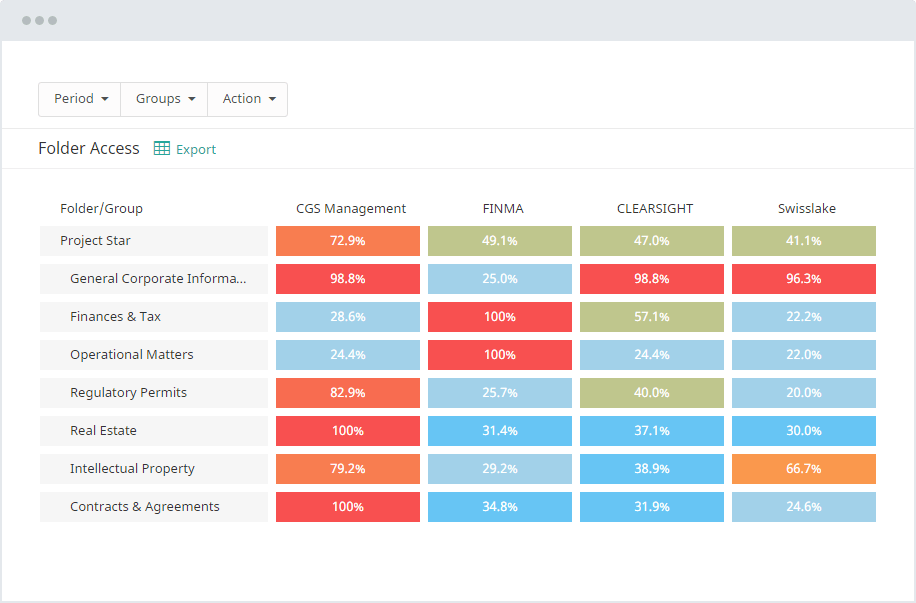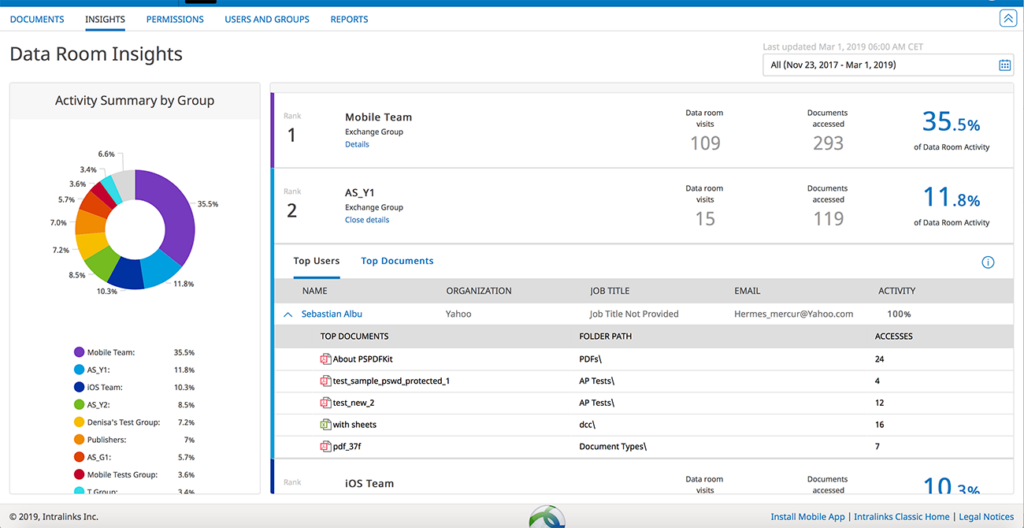
Keeping up with the times in business isn’t just about staying trendy—it’s about survival. So, if you are still locking up your sensitive documents in a physical room, it might be time to rethink your strategy!
Read on and explore virtual data rooms—a modern solution outpacing their physical counterparts in all ways. Whether it is global access to critical documents, top-tier digital security, or the convenience of managing everything online, data rooms are quickly becoming the go-to choice for business leaders across industries.
What is a physical data room?
A physical data room is a secure space where companies store highly confidential documents. It is typically used during the due diligence process in mergers and acquisitions, initial public offerings, legal transactions, and financial audits.
In this controlled environment, powered by restricted access, surveillance systems, and on-site supervision, authorized individuals can review sensitive information and collaborate on critical decisions.
Here are a few examples of specialized companies providing physical data rooms:
1. Iron Mountain
The service offers security physical data rooms, information protection, records management, and digital transformation. In addition, they provide extensive compliance and data security measures for improved information protection.
Source: Iron Mountain: A Trusted Name For Storage, Digitization, Data And Dividends
2. Shred-it
Known for its expertise in secure shredding and document destruction, the company also delivers secure document storage solutions focusing on confidentiality and compliance with data protection regulations.
3. Access Records Management
This secure physical storage combines traditional data rooms with modern digital access. By bridging the gap between physical and online storage, the company ensures the safety of physical documents and the convenience of digital access.
Although we discuss a traditional data room now, you may have noticed that “digital” frequently comes up. That’s because modern business operations rely on the ability to access, manage, and share data online to stay competitive, make informed decisions, and improve collaboration. So, our next step is to tell you more about virtual data rooms.
What is a virtual data room?
A virtual data room is a secure online environment used to store privileged data and collaborate from anywhere in the world. Typically, companies integrate the solution for mergers and acquisitions, due diligence, initial public offerings, strategic partnerships, real estate transactions, and other data-heavy deals.
What differentiates a virtual data room from generic file-sharing solutions and physical data storage is robust security mechanisms with advanced encryption, granular user permissions, and detailed audit trails.
Here is a quick overview of top-rated virtual data room providers:
Popular virtual data rooms
Overall rating:
4.9/5
Excellent

Overall rating:
4.8/5
Excellent

Overall rating:
4.7/5
Excellent
1. Ideals
The software offers top-notch security, excellent customer service, and a user-friendly interface. According to G2, it is the most easy-to-use solution in the market. The best Ideals features include eight-level document access rights, multi-layered data encryption, advanced Q&A, and AI-powered document management tools.
Ideals interface ⬇️

2. Intralinks
This vendor specializes in the energy, legal, and financial sectors. Their clients range from oil, gas, and renewable energy companies to banking, securities, and alternative investment firms. The Intralinks features include AI redaction for PII protection, dynamic folder indexing, and UNshare functionality.
Intralinks interface ⬇️

3. Datasite
Leaders across industries use this solution to manage complex M&A, capital raising, and restructuring transactions. For this, Datasite offers secure document sharing, AI-powered indexing, real-time analytics, and customizable workflows.
Datasite interface ⬇️
Modern business operations increasingly rely on online solutions, which is easy to explain. Unlike physical storage, which can be cumbersome and limited by physical space, virtual data rooms offer robust security, instant access to documents, and real-time collaboration wherever you are.
The evolution of physical data rooms to virtual data rooms
🔲Historical timeline
| ➡ Pre-1980s. Early data rooms were physical rooms with physical records and face-to-face meetings where access was controlled manually. |
| ➡ 1980s. The introduction of digital filing systems and early computers began to replace physical filing cabinets but did not yet support remote access or collaboration. |
| ➡ 1990s. Businesses started using basic digital storage systems but were limited by local data access. |
| ➡ Early 2000s. With the growth of the internet, companies began developing virtual data rooms, providing remote access to documents. |
| ➡ 2010s. Virtual data rooms became widely adopted across various industries, offering robust document security, real-time collaboration, and scalability. |
| ➡ 2020. Virtual data rooms integrated with AI, advanced analytics, and automated workflows, further enhancing their capabilities and addressing the growing need for efficient, secure, and sustainable document management. |
Let’s trace this evolution through the lens of business needs that physical storage could no longer satisfy but virtual solutions can address effectively.
1. Globalization and remote collaboration
As businesses expanded globally, the need for real-time, cross-border collaboration grew. While a physical room required physical presence and was inadequate for supporting remote teams, a virtual data room emerged as a solution for secure, instant access to documents from anywhere worldwide.
2. Efficiency and speed
The traditional processes involved in PDRs—such as transporting documents, setting up physical spaces, and managing access—were often cumbersome and slow. The digital nature of virtual data rooms streamlined these processes, allowing users to access documents instantly, benefit from advanced search capabilities, and automate workflows.
3. Cost reduction
Operating and maintaining a physical data room required substantial financial resources, including space, security, and personnel costs. VDRs, by contrast, offer a cost-effective and scalable digital alternative. They eliminate the need for physical infrastructure and reduce operational costs.
👁️🗨️10 Global compliance concerns for 2024: Advances in technology escalate fraud concerns | Thomson Reuters
4. Enhanced security and compliance
As regulatory requirements for data protection tightened, the limitations of physical data rooms in terms of security and compliance became evident. Online storage addressed these concerns with advanced security features meeting the stringent demands for data protection and regulatory compliance.
5. Environmental considerations
The growing emphasis on sustainability also played a role in the shift to digital solutions. PDRs contributed to significant paper waste and environmental impact due to physical document handling. In contrast, data rooms align with sustainability goals by reducing paper use and minimizing the ecological footprint of document management.
While physical data rooms still offer secure environments for storing and reviewing confidential documents, online solutions deliver convenience, accessibility, and advanced security features, making them the preferred choice for business leaders. However, there are many other reasons why teams go from papers to pixels.
Why do companies prefer a virtual data room over a physical data room?
Compare online data rooms with traditional storage across key areas and discover why virtual solutions surpass PDRs.
| Criteria | Physical data room | Virtual data room |
| Security | Physical security relies on physical access controls, such as key cards and security personnel. Risks include unauthorized access and theft. | Enhanced security with end-to-end encryption, multi-factor authentication, and granular user permissions eliminate the risk of data breaches. |
| Cost | High due to setup, maintenance, physical space, and staff. Frequent travel and document handling add to costs. | Subscription-based pricing with no need for physical space or travel expenses. |
| Convenience and flexibility | Limited flexibility requires physical presence or secure courier services for document handling. | 24/7 accessibility from any location with the internet allows for document sharing and real-time collaboration without restrictions. |
| Compliance | Depends on physical security measures and may involve complex document handling and auditing processes. | Includes built-in compliance features, such as audit trails, secure document handling, and regulatory adherence. |
| Document management and collaboration | Manual management with physical documents. Collaboration requires physical meetings or mail. | Streamlined document management with auto-data indexing, secure sharing, and real-time collaboration tools. |
| Data backup | Limited to physical backup solutions, which can be less reliable and more time-consuming. | Automated and regular backups maintain sensitive data integrity and availability. |
| Scalability | Limited scalability due to physical space constraints and logistical challenges. | Easily accommodates increasing data volumes and user access without additional physical infrastructure. |
Obviously, virtual data rooms outperform physical storage in all key areas. However, does this mean that all dealmakers should choose online platforms for document storage and collaboration during financial transactions?
Physical data rooms vs. Virtual data rooms: Use case scenarios
A virtual data room ensures improved accessibility, security, and efficiency. On the other hand, physical data rooms still hold value for specific business requirements. So, how do you make the choice?
When to use a physical data room?
- Situations requiring the utmost physical security. In scenarios where the highest level of physical security is paramount, such as dealing with highly sensitive government or military information, physical data rooms provide a controlled environment that can be tightly monitored and restricted.
✔️Use case examples: Government defense contracts, national security operations
- Lack of reliable internet access. Since physical rooms eliminate the dependency on digital infrastructure and ensure that all necessary documents are physically available, a PDR might be the only viable option in regions with unreliable or non-existent internet access.
✔️Use case examples: Remote oil exploration sites, rural development projects
When to use a virtual data room?
- Mergers and acquisitions and other data-heavy deals. The ability to quickly and securely share and review large volumes of data makes virtual data rooms an indispensable tool in high-stakes transactions.
✔️Use case examples: Corporate mergers, real estate transactions
- International transactions. Online solutions provide a centralized platform for data sharing and collaboration, no matter how many documents and parties are involved. Thus, they facilitate smoother cross-border transactions.
✔️Use case examples: Cross-border joint ventures, global M&A deals
- High-volume document management. Virtual data room tools like batch uploading, advanced search capabilities, and real-time updates make handling high volumes of data easy and less prone to error.
✔️Use case examples: Initial public offerings, legal proceedings
When deciding between physical and virtual data rooms, consider your business needs, data sensitivity, and logistical constraints. Thus, you will choose the most secure and effective solution for your business.
Key takeaways
- While traditional data rooms ensure secure handling of sensitive documents, virtual data rooms take it a step further by combining top-notch security with the convenience of global access and seamless collaboration.
- A virtual data room has evolved to meet the demands that physical storage could no longer satisfy. Online data centers enable global collaboration, boost efficiency, reduce costs, strengthen security, and support sustainability efforts.
- Physical rooms are still suitable for business operations demanding the highest physical security or where internet connection is unreliable. In contrast, virtual data rooms offer superior accessibility, security, and efficiency for data-heavy deals, cross-border transactions, and high-volume document management processes.
Choose the best virtual data room and empower your business with the solutions that drive growth!


